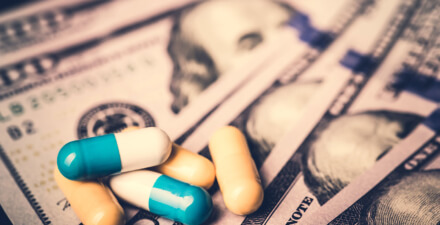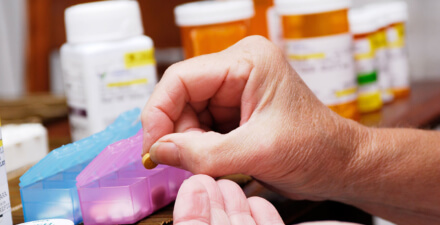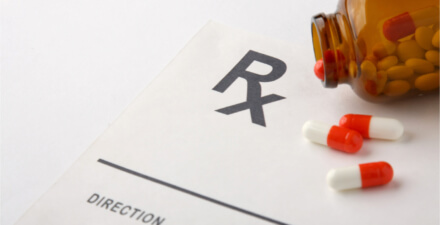Improving competition to lower U.S. prescription drug costs

This essay is part of Vision 2020: Evidence for a stronger economy, a compilation of 21 essays presenting innovative, evidence-based, and concrete ideas to shape the 2020 policy debate. The authors in the new book include preeminent economists, political scientists, and sociologists who use cutting-edge research methods to answer some of the thorniest economic questions facing policymakers today.
To read more about the Vision 2020 book and download the full collection of essays, click here.
Prescription drugs are among the most effective and cost-effective interventions in medicine, and the drug industry plays an important role in bringing these products to market, which can require substantial resources. Yet drug prices in the United States continue to rise without a direct connection to the costs of development, which can make breakthroughs unaffordable for many patients, leading to bad clinical consequences.
Rising drug prices also are a major driver of U.S. healthcare spending, now accounting for about one-fifth of overall spending, with one private insurer reporting that 25 percent of healthcare dollars are going to prescription drugs.1 The United States spent about $476 billion on prescription drugs in 2018.2 This is an increase of about $100 billion as compared to $361 billion in spending in 2014,3 with the discovery and testing of new drugs accounting for additional tens of billions of taxpayer and private dollars.
In recent years, there have been great advances in the use of prescription medications for treating heart disease and certain types of cancer, but high prescription drug prices have threatened to limit the availability of new transformative medications such as treatments for the hepatitis C virus infection,4 new gene therapies for devastating illnesses, and decades-old products such as insulin5 and antibiotics.6 By contrast, many key pharmaceutical therapies for chronic diseases such as high blood pressure and depression can be obtained for $4 per month or less, due to a vibrant generic drug marketplace in the United States.7
In this essay, I will review the origins of high prescription drug prices in the United States, as well as various policy mechanisms that can lead to more rational spending. There are four main periods in the development process of a prescription drug:
- The discovery process leading up to approval by the U.S. Food and Drug Administration
- The brand-name-only period of market exclusivity that lasts a median of 12–14 years or more after drug approval8
- The end of market exclusivity and the transition to a competitive market with the introduction of generic drugs
- The multisource generic drug period
High drug prices are driven by a variety of factors in each of these time periods, and the policy solutions that I present in this essay vary based on when in the process the drug currently sits. These policy recommendations, in their entirety, would dramatically lower spending on prescription drugs while ensuring continued funding for true innovation.
Drug discovery period
Government-funded research laboratories and those based in nonprofit academic centers are the origin of most key fundamental discoveries on which new drugs are based and are frequently cited in the research underlying new drugs.9 This support is derived from taxpayer funds through the National Institutes of Health. Whether the seminal study leading to the development of a new therapeutic approach arises through public support or in the private sector, considerable (and costly) work is then required to bring a drug to market. This is generally done within the pharmaceutical company that comes to own the intellectual property for a given compound.
Studies show the central role that public funding plays in the discovery, development, and even clinical testing of a growing number of transformative drugs.10 As a result, there is concern that the public funds this key research that generates innovation while manufacturers then obtain exclusive rights to the products and charge high prices to the very taxpayers who funded the research in the first place.
More government and academic institutions supported by public funding have sought to patent and license the discoveries they make that are relevant to drug discovery. In a recent study, my colleagues and I examined all new drugs—excluding biologics, or those drugs produced from living organisms, as opposed to drugs produced through chemical synthesis—approved in the United States from 2008–2017 and found that publicly supported research in nonprofit institutions or spin-off companies that had their origins in public-funded research made important late-stage intellectual contributions to at least one in four of these new drugs.11 But few such patent licenses have traditionally not had clauses that restrict manufacturers’ ability to charge excessive prices to government payers or return royalties to support future public funding of science.
Policy recommendations for the drug discovery period
One way to lower drug prices when public funding leads to patents covering approved prescription drugs would be for the National Institutes of Health to require a reasonable pricing provision in the technology transfer from the public sector to the private sector. This provision could, for example, require that the ultimate price of the product be no greater than its value-based price—a price reflecting the drug’s potential ability to improve patient outcomes over comparable interventions—as determined by independent organizations.
A less-effective version of such a clause was part of the NIH Combined Research and Development Agreement process from 1989–1995, but it was never implemented fully and ultimately was dropped under substantial lobbying pressure from the pharmaceutical industry.12
Notably, according to the Bayh-Dole Act of 1980, which established the basic rules for commercialization of technology arising from government funding, the federal government retains a license in such patents and can even “march-in” to invalidate an exclusive commercialization license if the product is not made available on “reasonable terms.” The NIH, however, does not interpret reasonable terms as applying to pricing and has never invoked the march-in provision when public interest groups have requested such a move.
In addition, few drugs have all of their patents linked to government funding because pharmaceutical manufacturers usually build a broad thicket of dozens, or hundreds, of patents around the product prior to approval. So, it is unlikely that greater reliance on the march-in provision will serve as an effective lever to reduce drug prices in all but a few cases.13
Finally, it is important for policymakers to recognize that focusing on patented technology misses the manifold ways that information and insights generated by publicly funded science get taken up by for-profit manufacturers and applied to drug discovery. Many of the policy proposals discussed subsequently in this essay can lead to more rational drug prices and are ethically justified by the publicly supported science currently serving as a primary engine of innovation for the for-profit pharmaceutical industry.
Brand-name-only period
After drugs are approved by the U.S. Food and Drug Administration, manufacturers hold patents and other exclusivities on their products to prevent direct competition. There is thus no direct competition that could help lower drug prices. Competition between brand-name drugs that treat the same conditions has not been shown to effectively lower prices, apart from a few cases. In such an environment, the most direct way to lower prices is to empower the buyers to negotiate better terms with the exclusivity-holding manufacturers. So, the best solution is to provide the U.S. government with the authority to negotiate reasonable prescription drug prices that reflect the value that the treatments provide to patients.
Currently, in the United States, brand-name manufacturers can set any price they choose during the market exclusivity period, while the buyers’ markets for prescription drugs are served by a patchwork of public and private payers with far less equivalent negotiating power.14 Medicare—the government program that covers payment for people older than 65 years of age—is forbidden by law from negotiating prices with drug manufacturers. This is despite Medicare’s ability to negotiate or set the price for every other kind of medical service it covers. This imbalance in power between the sole-source supplier and the multiple, competing buyers is made worse by various rules and restrictions on the payers and their abilities to decline to cover certain drugs.
Medicare Part B, for example, accepts payment rates for FDA-approved drugs based on their average sales price, and Medicare Part D plans must cover at least two drugs in each class in addition to substantially all drugs in six “protected classes” (including cancer and HIV).15 But Medicare cannot negotiate the price of these mandatory drugs on behalf of the individual plans that implement coverage. Similarly, Medicaid programs, which cover care for the poor and disabled, are required to list virtually all FDA-approved drugs on their formularies.16
In the private sector, insurers can refuse to pay for particularly costly drugs that have equivalently less expensive alternatives, but they may also impose high co-payments to discourage patient demand for such lower-value medications. The latter approach is counteracted by manufacturer coupons to patients and patient assistance programs.17 For these and other reasons, commercial payers receive lower rebates, on average, than Medicare.
Policy recommendations for the brand-name-only period
During this period, the most direct way to address excessive drug prices would be for the government to negotiate the price of drugs. Numerous other countries have health technology assessment organizations that assess a newly approved drug’s clinical value and help determine what a fair price would be based on how well it is expected to perform against other available treatments.18 These publicly funded organizations gather data on the effectiveness, safety, and cost of new drugs, compared with other interventions, to assess whether the payer should cover the price.
This does not occur in the United States, making it difficult for value-based assessments to drive medication use and cost. Currently, several smaller public and private entities take on this role.19 The United States needs a similar body operating at the national government level that can make such a determination within the first year after approval; until then, manufacturers might be permitted to charge the price they believe is appropriate.20 Past legislative efforts to establish such a body have been derailed by the political process, but it would be best situated within the Department of Health and Human Services and could accept information about the cost of development and cost of failure as a way of determining a rational, value-based price.
Once the price is established, price increases each year should not be able to exceed inflation, unless the manufacturer brings new evidence that changes knowledge about the drug’s value. Similarly, future technology that lowers the cost of care for the indication should lead to price declines. As a safety net for particularly essential and high-priced medications for which a negotiated price cannot be reached, the government has the authority to reimburse pharmaceutical manufacturers at a fair market-value price for use of their intellectual property (along with a reasonable royalty rate to account for the cost of failure) under Section 25 of the U.S. Code, §1498.21
During this period, brand-name pharmaceutical manufacturers spend billions of dollars annually to persuade physicians and patients to use their products, but there is a shortage of noncommercial information disseminated about drug benefits, risks, and cost effectiveness. As an alternative, we need to support independent programs designed to generate unbiased information about evidence-based management of disease and then invest in actively disseminating this educational information to physicians, so that it can translate optimally into more cost-effective prescribing.22
In addition, at present, manufacturers are limited to only actively promoting their drugs primarily for the diseases or conditions that the FDA has reviewed and approved, even though prescribing for non-FDA-approved (or “off label”) prescription drug uses can be common. Recent federal court decisions interpreting the First Amendment have extended protection of commercial speech and put these rules in jeopardy, potentially allowing manufacturers to engage in widespread promotion of off-label drug uses. Such uses often lack the same level of evidence as FDA-approved uses, and so can be potentially dangerous to patients.23 And they can be costly to the system, too.24 Thus, the FDA must reaffirm its commitment to current off-label marketing rules, which should be enforced even under the evolving commercial speech doctrine in this area.25
Transition to a competitive market period
The only type of competition that consistently and substantially lowers drug prices comes from introduction to the U.S. market of interchangeable, FDA-approved generic drugs. When the market exclusivity period ends for a given medication, generic manufacturers can enter the market and prices generally fall, reducing healthcare spending by patients and payers and promoting greater access to the drug.26
Yet brand-name manufacturers often employ product life-cycle management strategies to extend market exclusivity periods.27 This involves exploiting the interpretations of the standards for patenting under the Patent Act and seeking “secondary” patents on peripheral aspects of the drug, such as its appearance or coating, that can extend market exclusivity periods indefinitely. In one review of two HIV medications, my colleagues and I identified 108 different patents covering the products that could have extended their market exclusivity by 12 years or more.28 This practice also can be extended further to “tertiary” patents covering a drug’s delivery via a device, such as an injectable pen, a patch, or an inhaler.29
Secondary and tertiary patents also enable product-hopping strategies, in which manufacturers introduce new versions of their products with incremental changes that do not provide advancements in drug efficacy, safety, or convenience that are commensurate to the higher prices being charged. In one case, a manufacturer of an antibiotic successively changed its formulation from capsules to tablets and then altered its strength and scoring marks, allowing it to stay ahead of generic entry.30
In addition, manufacturers use various strategies to prevent the timely entry of generic drugs. These include filing Citizen Petitions with the Food and Drug Administration, restricting supplies of their product for generic manufacturers to use in bioequivalence studies, and entering into settlements with generic manufacturers seeking to challenge patents that include agreements to drop the challenge and delay or terminate its plans to market a competing generic product.
Policy recommendations during the transition to a competitive market period
There are currently some pieces of legislation being considered in Congress that try to address generic-delaying strategies in a piecemeal way, such as by making it illegal to restrict samples or requiring greater disclosure of a product’s patent landscape. Similarly, more common use of the administrative Patent Trial and Appeals Board’s patent review process—such as automatic Patent Trial and Appeals Board review at the time any drug patent is listed with the FDA—could help weed out insufficiently innovative patents.31 Congress also could change federal law and direct the Food and Drug Administration to grant interchangeability ratings to drugs that offer nonclinically significant changes.
The states also have a role to play. Regulations permitting or requiring the substitution of generic drugs for brand-name products is managed at the state level, with variation across the states. These state laws could be adapted to permit “therapeutic substitution” of drugs proven to work comparably even if they are not pharmaceutically equivalent, such as a tablet and a capsule.
Another policy solution that would help prevent secondary and tertiary patents from delaying generic entry would be to restrict a brand-name drug’s market exclusivity period to a particular time period and not permit secondary or tertiary patents—or any of the other strategies—from being able to block FDA approval of a generic version. My colleagues and I have proposed that manufacturers be restricted to the single patent for which they seek and receive Patent Term Restoration (a period of up to 5 years to account for time spent in clinical trials and FDA review), plus the 6-month patent extension manufacturers receive for testing their drugs in children. At the end of this period, generics should be permitted to enter, no matter what other patents have been obtained. The failure of a generic to enter the market should spark a formal federal investigation to determine whether some anticompetitive strategies have been used.
Multisource generic period
After a drug has lost exclusivity protection, prices may not fall if there are not enough generic manufacturers in the market.32 Similarly, older, off-patent drugs can transition from markets served by multiple manufacturers to markets served by three or fewer, allowing the remaining manufacturers more flexibility to raise prices. Such older products may not be lucrative enough for other generic manufacturers to enter the market.
Policy recommendations for the multisource generic period
In the past, long delays in generic drug approval times at the FDA have limited generic entry in these kinds of cases, but the agency has substantially accelerated review times due to increased funding from user fees starting in 2012. More resources must be invested at the FDA to ensure that there are not unnecessary delays in generic drug approval and that guidances are produced in a timely fashion for the types of studies generic manufacturers will need to complete to receive FDA approval of interchangeable products, particularly for complex small molecule products (generic versions of nonliving organic compounds) and biosimilars (competitor versions of biologic drugs).
Importation is a possible solution in cases of high prices for off-patent drugs, particularly if there are manufacturers selling these products in other similar regulatory systems around the world that, for any reason, have decided not to pursue FDA approval yet. In one study of 170 off-patent drug products being sold in the United States by three or fewer manufacturers, more than half (109, or 64 percent) had at least one manufacturer approved by a non-U.S. regulator and 32 (19 percent) had four or more.33
In these cases, a process for facilitating United States-wide imports, followed by an expedited process for formal FDA approval, could help prevent and respond to price spikes.34 Here’s just one example: Pyrimethamine—the drug used for a complication of advanced HIV that was famously subject to a 5,000 percent price increase in the U.S. market by Turing Pharmaceuticals, from $13.50 to $750 per pill—is being sold by some manufacturers for as little as $0.03 per pill.35
Another solution would be to pursue a system of government-sponsored drug manufacturing. In recent years, some private organizations have developed their own efforts at drug manufacturing, and other nonprofit drug manufacturers have emerged. A government-run manufacturing plant, as proposed in Congress in 2018, could be set up to ensure a continued supply of off-patent products that for-profit generic manufacturers have lost interest in producing.
Download FileImproving competition to lower U.S. prescription drug costs
Conclusion
There is no one single solution for reducing unnecessary spending on prescription drugs because the market changes so substantially during the course of a drug’s development and then its widespread use after FDA approval. But with sensible changes directed toward the different forces that affect the market at different times, the United States can help contain rising drug costs, better ensure that we pay for clinical value in the system—rather than whatever price drug manufacturers believe they can extract—and better ensure availability of important drugs for the patients who need them.
—Aaron S. Kesselheim is a professor of medicine at Harvard Medical School Program and the Director of the Program On Regulation, Therapeutics, And Law, or PORTAL, in the Division of Pharmacoepidemiology and Pharmacoeconomics in the Department of Medicine at Brigham and Women’s Hospital. His research is supported by Arnold Ventures, with additional support from the Engelberg Foundation and the Harvard-MIT Center for Regulatory Science.
End Notes
1. Michael Sherman and others, “Prescription Medicines Account for One in Four Dollars Spent by a Commercial Health Plan,” Health Affairs blog, August 24, 2018, available at https://www.healthaffairs.org/do/10.1377/hblog20180821.820628/full/. Estimates of how much health care spending among public and/or private payors is accounted for by prescription drugs vary depending on the data used and what is being measured. The best estimates range from 17 percent from the national government to 25 percent as provided in this reference.
2. Glen T. Schumock and others, “National Trends in Prescription Drug Expenditures and Projections for 2019,” American Journal of Health System Pharmacy 76 (15) (2019): 1105–1121.
3. Glen T. Schumock and others, “National Trends in Prescription Drug Expenditures and Projections for 2015,” American Journal of Health-System Pharmacy 72 (9) (2015): 717–736.
4. Brandy Henry, “Drug Pricing & Challenges to Hepatitis C Treatment Access,” Journal of Health and Biomedical Law 14 (2018): 265–283.
5. Jing Luo and others, “Strategies to improve the Affordability of Insulin in the USA,” Lancet Diabetes and Endocrinology 5 (3) (2017): 158–159.
6. Jonathan D. Alpern and others, “Trends in Pricing and Generic Competition within the Oral Antibiotic Drug Market in the United States,” Clinical Infectious Diseases 65 (11) (2017): 1848–1852.
7. Patrick Liu and others, “Medicare Beneficiary Out-of-Pocket Costs for Generic Cardiovascular Medications Available Through $4 Generic Drug Discount Programs,” Annals of Internal Medicine 169 (11) (2018): 817–819.
8. Bo Wang, Jun Liu, and Aaron S. Kesselheim, “Variations in Time of Market Exclusivity among Top-Selling Prescription Drugs in the United States,” JAMA Internal Medicine 175 (4) (2015): 635–637.
9. Ekaterina Galinka Cleary and others, “Contribution of NIH Funding to New Drug Approvals 2010-2016,” Proceedings of the National Academy of Sciences of the USA 115 (10) (2018): 2329–2334.
10. Aaron S. Kesselheim, Tan YT, and Jerry Avorn, “The Roles of Academia, Rare Diseases, and Repurposing in the Development of the Most Transformative Drugs,” Health Affairs 34 (2) (2015): 286–294.
11. Rahul Nayak, Jerry Avorn, and Aaron S. Kesselheim. “Public Support for Late-Stage New Drug Discovery; Cohort Study,” BMJ 367 (2019): l5766.
12. Rebecca Wolitz, “The Pay-Twice Critique, Government Funding, and Reasonable Pricing Clauses,” Georgia State University College of Law Journal of Legal Medicine Symposium (2019), available at https://ssrn.com/abstract=3440799.
13. Carolyn L. Treasure, Jerry Avorn, and Aaron S. Kesselheim, “Do March-In Rights Ensure Access to Medical Products Arising from Federally Funded Research? A Qualitative Study,” Milbank Quarterly 93 (4) (2015): 761–787.
14. Aaron S. Kesselheim, Jerry Avorn, and Ameet Sarpatwari, “The High Cost of Prescription Drugs in the United States: Origins and Prospects for Reform,” JAMA 316 (8) (2016): 858–871.
15. Thomas J. Hwang and others, “Analysis of Proposed Medicare Part B to Part D Shift with Associated Changes in Total Spending and Patient Cost-Sharing for Prescription Drugs,” JAMA Internal Medicine 179 (3) (2019): 374–380.
16. Benjamin D. Sommers and Aaron S. Kesselheim, “Massachusetts’ Proposed Medicaid Reforms—Cheaper Drugs and Better Coverage?” New England Journal of Medicine 378 (2) (2018): 109–111.
17. Joseph S. Ross and Aaron S. Kesselheim, “Prescription-Drug Coupons—No Such Thing As a Free Lunch,” New England Journal of Medicine 369 (13) (2013): 1188–1189.
18. Jing Luo and Aaron S. Kesselheim, “Setting Prescription Drug Prices: A Comparison of Strategies in the US, UK, Canada, Australia, and Germany,” Harvard Health Policy Review 15 (2) (2016): 4–9.
19. Steven D. Pearson, “The ICER Value Framework: Integrating Cost Effectiveness and Affordability in the Assessment of Health Care Value,” Value in Health 21 (3) (2018): 258–265.
20. Ariel D. Stern and others, “The impact of price regulation on the availability of new drugs in Germany,” Health Affairs 38 (7) (2019): 1182–1187.
21. Amy Kapczynski and Aaron S. Kesselheim, “Government ‘Patent Use’: A Legal Approach to Reduce Drug Spending,” Health Affairs 35 (5) (2016): 791–797.
22. Jerry Avorn, “Academic Detailing: ‘Marketing’ the Best Evidence to Clinicians,” JAMA 317 (4) (2017): 361–362.
23. Food and Drug Administration, “Public Health Interests and First Amendment Considerations Related to Manufacturer Communications Regarding Unapproved Uses of Approved or Cleared Medical Products” (2017).
24. Aaron S. Kesselheim, Michelle M. Mello, and Jerry Avorn, “FDA Regulation of Off-label Drug Promotion under Attack,” JAMA 309 (5) (2013): 445–446.
25. Aaron S. Kesselheim and Michelle M. Mello, “Prospects for Regulation of Off-Label Drug Promotion in an Era of Expanding Commercial Speech Protection,” University of North Carolina Law Review 92 (5) (2014): 1539–1604.
26. William H. Shrank and others, “State Generic Substitution Laws Can Lower Drug Outlays under Medicaid,” Health Affairs 29 (7) (2010): 1383–1390.
27. Kerstin N. Vokinger and others, “Strategies That Delay Market Entry of Generic Drugs,” JAMA Internal Medicine 177 (11) (2017): 1665–1669.
28. Amin T and Aaron S. Kesselheim, “Secondary patenting of branded pharmaceuticals: a case study of how patents on two HIV drugs could be extended for decades” Health Affairs 31 (2012): 2286–2294.
29. Reed F. Beall and Aaron S. Kesselheim, “Tertiary Patenting on Drug-Device Combination Products in the United States,” Nature Biotechnology 36 (2) (2018): 142–145.
30. Federal Trade Commission, “FTC Files Amicus Brief Explaining That Pharmaceutical ‘Product Hopping’ Can Violate Antitrust Laws,” Press release, October 1, 2015, available at https://www.ftc.gov/news-events/press-releases/2015/10/ftc-files-amicus-brief-explaining-pharmaceutical-product-hopping.
31. Jonathan J. Darrow, Reed F. Beall, and Aaron S. Kesselheim, “The Generic Drug Industry Embraces a Faster, Cheaper Pathway for Challenging Patents,” Applied Health Economics and Health Policy 17 (1) (2019): 47–54.
32. Chintan V. Dave, Abraham Hartzema, and Aaron S. Kesselheim, “Prices of Generic Drugs Associated with Numbers of Manufacturers,” New England Journal of Medicine 377 (26) (2017): 2597–2598.
33. Ravi Gupta and others, “Availability of US Off-Patent Drugs at Risk for Acute Price Increases or Shortages from Manufacturers Approved by Non-US Regulators,” BMJ 360 (2018): k831.
34. Thomas J. Bollyky and Aaron S. Kesselheim, “Can Drug Importation Address High Generic Drug Prices?” White Paper (The Brookings Institution, 2017), available at https://www.brookings.edu/research/can-drug-importation-address-high-generic-drug-prices/.
35. Michael A. Carrier, Nicole L. Levidow, and Aaron S. Kesselheim, “Using Antitrust Law to Challenge Turing’s Daraprim Price Increase,” Berkeley Technology Law Journal 31 (2) (2016): 1379–1408.






